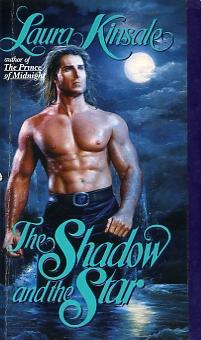The Shadow and the Star
A charming 5-yen story full of holes
By William Wetherall
First posted 20 October 2006
Last updated 20 October 2006

Laura Kinsale Fans of such fiction could probably tell you the name of the model for the hunk on the cover. I can't. The shadowy starsThe principle characters in this historical romance are introduced on the back cover.
The story is a bit convoluted. The odd chapters, from 1-19, unfold in London feature Leda Etoile and Samuel Gerard in 1887. The even chapters, from 2-18, unfold in Hawaii, and tell the story of how Gerard came to be the Shadow, a master of darkness, martial arts, Japanese, and women, from 1869-1882. From Chapter 20, the stories converge in Hawaii in the late 1880s. SumimasenThe story is a mystical mishmash of things Japanese, Hawaiian, Chinese, and English, involving a hodgepodge of characters and venues. There are Chinatowns and plantations, Chinamen and Orientals and Hawaiians and Haoles, royalty from both Japan and the Sandwich Islands, plus a martial arts guru named Dojun who speaks pidgin and makes his points with tales about the samurai warriors. Page 1 of the brief preface introduces "The Shadow Warrior" first in terms of kabuki, kuroki, and tabi -- then in terms of "Earth . . . water . . . wind . . . fire . . . and the void." The enigmatic figure simply "rose to his feet and vanished" (page 2). The English narrative and dialog is strewn with Japanese and Hawaiian words and expressions, italicized so you can't miss them, and glossed in proper tour-guide-ese in case you want to what the author thinks they mean. Here is a sample of the action.
Symbol of friendshipThe whole story is overboard. Leda Etoile, the Star, cherishes a 5-yen coin on a ribbon given her by Samuel Gerard, the Shadow and man of her dreams (pages 204-205). She dropped her eyes. He caught her hand in the same instant, pressing a small roll of cloth into it. This lays the foundation for a later scene (page 252). Her heart ached for him. There are two problems here. One: The 5-yen coin, first minted in 1870 and redesigned in 1897, was a gold piece -- for then, five-yen was a huge amount of money. Two: Meiji coins did not have holes in them -- so how could the coin have been "on a thin ribbon"? History of 5-yen coinMeiji coins did not have holes. The first post-Meiji coin to be holed was the nickel 5-sen piece struck from 1917. The brass 5-yen coin, minted in 1948, did not have a hole -- which appeared in the 1949 design. The 50-yen coin was not holed until 1959. "5-yen" is "go-en" in Japanese. The "yen" spelling reflects an older orthography of what was pronounced and is now written "en". Since "go-en" is homophonous with a word which means "[good] ties, relationships, marriage, karma, fate, luck", some people have carried a 5-yen coin or bill, or given one to someone, "in order to have go-en" [go-en ga aru yo ni]. Since "yen/en" is a Meiji denomination, the superstition about 5-yen coin (and 5-yen bills) could not have begun before then. I am presently trying to find out when the practice of carrying such currency on strings or in wallets, as good-luck charms, began. In the United States, people are known to have bored holes near the rims of coins to carry them on a string or chain. Would anyone in the Meiji period have made a hole in a gold piece in order to use it as a "relationship" charm? |